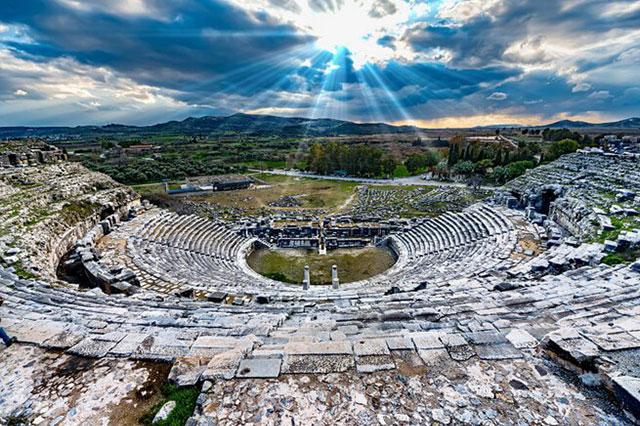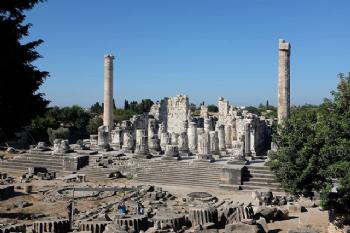
*(A true gem among Didim attractions, and a highlight of many Didim daily tours)_
Miletus, one of the most historically rich cities of the ancient world, is just a 30-minute drive from Didim, and is frequently featured in daily excursions from Didim and cultural sightseeing packages. Once a thriving coastal city, it now sits inland due to the silt deposits from the Meander River, but it remains one of the most significant Didim attractions for history lovers.
In ancient times, Miletus was the intellectual, commercial, and cultural hub of Ionia. For travelers looking for meaningful Didim excursions and educational experiences, a visit to Miletus is an unforgettable journey into the past.
In its prime (around 7th century BC), Miletus was so powerful that it established over 90 colonies throughout the Mediterranean and Black Seas — including cities like Sinop, Trabzon, and even Marseille.
Most famously, Miletus is known as the birthplace of philosophy, producing great thinkers like Thales, Anaximander, and Anaximenes.
It was also the first city to implement an organized urban design thanks to Hippodamos, considered the world’s first urban planner. His grid system, applied 2,500 years ago, remains a marvel in the study of city planning today.
All of this makes Miletus a key stop in any list of things to do in Didim.
Visitors taking part in tours from Didim will be amazed by the sheer size and preservation of this ancient site. Key landmarks include:
🏟️ Great Theater – Seating 15,000 people, this massive structure offers remarkable acoustics and visibility.
🛁 Baths of Faustina – One of the best-preserved Roman-era social complexes.
🏛️ Agora & 100-meter Ceremonial Road – A wide avenue once lined with shops and civic buildings.
🔥 Bouleuterion (Council House) – Where city decisions were made under a sacred flame.
🌾 Sanctuaries of Demeter & Kore – Temples dedicated to fertility goddesses.
✝️ Episcopal Church and early Christian cemetery
🕌 Isa Bey Mosque (1404) – A beautiful example of Seljuk architecture with marble ornamentation.
🧱 Restored Gymnasium (Training Area) – Used by young citizens for sports and education.
🧭 Temple of Athena – Built on a hill south of the agora, with some columns still standing.
🏠 Ancient Residences – Offering insights into daily life and household culture.
Near the site entrance, you’ll find:
🍽️ A small restaurant, café, and public restrooms
🏺 The Miletus Museum, located on the way back to Didim, which displays statues, coins, inscriptions, and artifacts unearthed from the area
Whether you're on a guided tour in Didim or exploring independently, Miletus offers a well-rounded historical experience for all types of travelers.
📸 Ideal for lovers of ancient history, architecture, and photography
👨👩👧👦 Suitable for families, couples, groups, and solo travelers
🧠 A fascinating destination for educational trips and culture seekers
🚌 Included in most Didim daily tours and day trips from Didim
✅ A unique alternative to crowded tourist spots
Whether you're looking for guided tours in Didim, enriching Didim activities, or simply wondering what to do in Didim, Miletus offers timeless inspiration.
Book a unique Miletos right now.
